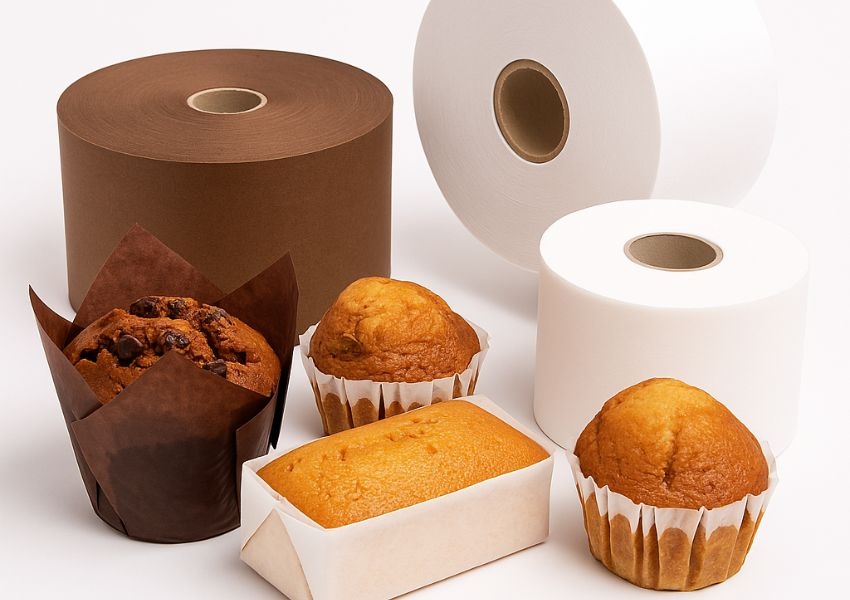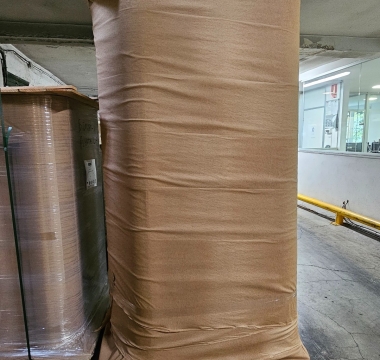In this article, we explore exactly what greaseproof paper is, its benefits, main applications and why it has become essential for so many food-related businesses.
What is greaseproof paper and how does it work?
Greaseproof paper is a specially treated type of paper that repels oils, fats and moisture. It is designed to act as a barrier between the food and the environment, preserving the integrity of the product without altering its flavour or texture.
Specific treatments
Unlike regular paper, greaseproof paper undergoes a treatment that reduces its porosity and prevents fat penetration. This can be mechanical—through special pressing—or chemical, using food-grade coatings approved for direct food contact.
Key characteristics of greaseproof paper
- High resistance to oils and hot liquids: It remains intact without deforming or tearing.
- Food-safe certified: Complies with European food safety regulations.
- Customisable: Can be printed with logos, brand colours or decorative designs using food-safe inks.
- Multiple formats available: Sheets, rolls or pre-cut formats to suit different uses.
Practical applications of greaseproof paper
Greaseproof paper is widely used in different food industry sectors, from HoReCa channels to artisanal and gourmet businesses.
In food service and hospitality
Restaurants, cafés, and fast food chains use greaseproof paper for:
- Wrapping burgers, kebabs, and hot sandwiches.
- Serving fried snacks: calamari, croquettes, chips, etc.
- Holding oily tapas or dressed salads.
Its clean and attractive presentation makes it ideal for both dine-in and takeaway.
In bakeries and patisseries
Artisanal baked goods often contain high fat content. In this context, greaseproof paper helps:
- Prevent grease from staining trays, bags or boxes.
- Enhance the product’s appearance at the point of sale.
- Preserve freshness by avoiding moisture buildup.
In food trucks and events
Street food businesses and gastronomic events like fairs or markets rely on greaseproof paper for its convenience and effectiveness. It’s perfect for serving food quickly while maintaining hygiene.
In takeaway and delivery services
With the rise of food delivery, greaseproof paper plays a vital role in:
- Preventing oil stains in delivery bags.
- Keeping food in optimal condition during transport.
- Communicating professionalism and care through neat packaging.
Benefits of greaseproof paper over other options
1. Improved hygiene
The main function of greaseproof paper is to protect both the food and the customer. Acting as a barrier, it prevents oil from transferring onto surfaces or hands, ensuring a cleaner, safer eating experience.
2. Branding opportunities
Thanks to its printability, greaseproof paper also serves as a marketing tool. Custom-printed wrappers enhance brand recognition and help create a memorable impression.
3. Sustainable options
Many types of greaseproof paper are recyclable or made from sustainably sourced materials. This aligns packaging with environmentally responsible business practices.
4. Versatility
Available in a wide variety of sizes and styles, greaseproof paper is suitable for catering trays, product separators, wrap-around packaging, decorative liners and more.
How to choose the right greaseproof paper
Not all greaseproof paper is created equal. When choosing the most suitable product, consider the following:
1. Paper weight (gsm)
The paper´s thickness should match the type of food. Lighter weight papers may be insufficient for greasy products, while heavier options could increase cost without adding value.
2. Type of treatment
Always ensure the treatment is food-safe and appropriate for the temperature and texture of the food.
3. Print compatibility
If branding is required, check that the paper supports food-grade printing and delivers sharp, durable results.
4. Format and presentation
Depending on your operational needs, choose between rolls, sheets, wraps, or custom-cut formats. Options range from white to kraft to printed finishes.
Looking for ideas on how to store and organise food wrapped in greaseproof paper?
If you´re interested in optimising the use of greaseproof paper, check out this related article:
Storage Solutions for Food Wrapped in Greaseproof Paper
There you´ll find practical tips on keeping your products well-presented and efficiently stored.
Conclusion: a strategic choice
Greaseproof paper is more than just packaging. It´s a strategic tool that enhances food quality, hygiene, and presentation. Its strength, adaptability and customisability make it a go-to choice for businesses that want to deliver exceptional service and stand out from the competition.
At Arrosi, we offer a wide range of greaseproof paper in various formats, weights and styles to meet the needs of bakeries, restaurants, cafés, and large-scale food producers. Discover our full product range here: Greaseproof Paper at Arrosi




